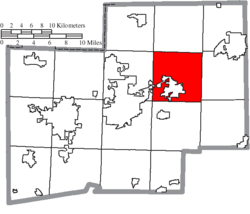Nimishillen Township
| Nimishillen Township, Stark County, Ohio | |
|---|---|
| Township | |

Molly Stark Sanitarium on Columbus Road
|
|
 Location of Nimishillen Township in Stark County |
|
| Coordinates: 40°50′56″N 81°16′14″W / 40.84889°N 81.27056°WCoordinates: 40°50′56″N 81°16′14″W / 40.84889°N 81.27056°W | |
| Country | United States |
| State | Ohio |
| County | Stark |
| Area | |
| • Total | 31.7 sq mi (82.1 km2) |
| • Land | 31.6 sq mi (81.9 km2) |
| • Water | 0.1 sq mi (0.2 km2) |
| Elevation | 1,145 ft (349 m) |
| Population (2000) | |
| • Total | 9,098 |
| • Density | 287.8/sq mi (111.1/km2) |
| Time zone | Eastern (EST) (UTC-5) |
| • Summer (DST) | EDT (UTC-4) |
| FIPS code | 39-55944 |
| GNIS feature ID | 1086983 |
Nimishillen Township is one of the seventeen townships of Stark County, Ohio, United States. The 2000 census found 9,098 people in the township.
Located in the eastern part of the county, it borders the following townships:
Two cities are located in Nimishillen Township: Louisville in the south, and a small part of Canton, the county seat of Stark County, in the southwest.
It is the only Nimishillen Township statewide. According to tradition, Nimishillen Township was named for the Nimishillen Creek that takes its rise mainly in the township. This stream was originally named by local Native Americans, as a combination of missilla (black alder, or American Winterberry, a common tree along the stream) plus ni (stream or water).
The first settlers arrived in the area between 1805 and 1807, founding Nimishillentown, and organizing Nimishillen Township in 1809.
Nimishillen Township has always been deeply interested in self-government. Its earliest trustees, elected in 1809, were Jacob Shively, Jesse Fetts and John Gans. Other early township officials were township clerk John Rupert; constable James Coney; treasurer Mathias Bower; appraiser of property Isaac Clay; overseer of the poor George Shidler; fence supervisor John Miller; and road supervisor Michael Miller.
The courts were composed of juries chosen by the trustees and presided over by Justices of the Peace. Schools were also established by the township, and for this purpose the trustees carried out a census of heads of households. Early township clerks were responsible for recording livestock brands, apprenticeship indentures, and the names of men whose wives required them not to use alcohol.
...
Wikipedia
